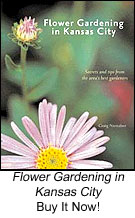Visit
Our Website
Previous
Issues
Buyer's
Guide
Tell A
Friend
Donations
Send
A Postcard!
Bookstore
Magazines
Gardening
Catalogs
Site
Search
Contact
Us
Submit
A Tip
Feature
Articles
Rose
Tips
What's
Hot...
Nuisance
of the Week
Turf
Tips...
Winter
Wisdom
Gardener's
Glossary
Books
We Love
Great
Products
Web
Resources
Event Calendar
Local
Sponsors
Subscribe
Tell
A Friend
Privacy
Pledge



|
Fall, Friends, Forty...
Could it be that fall has arrived? Although this
year's autumnal equinox is
officially on September 22nd the cooler temperatures
we experienced this morning lead me to believe that we might be
getting an early taste. The change in the temperature sure is
welcomed. I am ready for days of jeans, sweatshirts, soccer games
and football season. I look forward to the days of piddling in
the garden preparing it for its long winter's
nap. Planting new shrubs (or finding a place to plant new shrubs),
dividing perennials that are long overdue for some much needed
space, and planning my next big
project. Welcome fall - I'm glad you're here!
Isn't it
great to live close to friends and neighbors that share things
from their gardens? We have both - Donald, Anna, Ryan and Brady
Friend live across the street from us and tried their hand at
growing some tomatoes this summer. We
are delighted with their success and even more delighted that
they chose to share their harvest with us. Cherry tomatoes,
jalapeño peppers and banana peppers
(photo).
Yummy! Thanks Friend's for sharing your produce.
Kevin turns
40 (finally) on September 19th. I know that he would love to hear
from you so
send him a note to let him know that 40 is not older but
better. Happy Birthday to my better half!
~
Shelly
Totally Tulips (Part 2)
One of the best ways to keep your spring garden flowering is
by planting tulip bulbs that bloom at different times.
Last week we recommended some tulip varieties that would
bloom toward the early part of spring. This week we focus on
those that will bloom after the early bloomers but just before
the late bloomers. Careful planning will pay off next spring
with a continuously blooming tulip garden.
-
Darwin Hybrid Tulips are highly prized for their large,
brilliant flowers. Flowers are available in shades of red,
pink, orange, and yellow. Blooms are borne on strong stems
which are up to 30 inches tall. Darwin hybrid tulips often
bloom well for several years, making them one of the better
perennial tulips.
-
Triumph Tulips produce cup-shaped flowers on strong,
medium-length stems. Average plant height is 10 to 16 inches.
This is the largest class of tulips and offers the widest range
of flower colors. Triumph tulips are excellent for forcing.
-
Parrot Tulips have deeply feathered, curled, or twisted
petals. Flowers may be single or multi-colored. Many
varieties have a green spot at the base of their petals.
Parrot tulips are sensitive to poor weather and should be
planted in a protected spot.
Next week,
the late bloomers...
Source
Twig Girdlers
In Trees...
If you've noticed small twigs laying around the yard chances are
good that twig girdlers are to blame and the beetle
Oncideres cingulata is the most likely culprit. Host trees
include elm, oak, linden, hackberry, apple, pecan, persimmon,
poplar, sour gum, honeylocust, dogwood, and some flowering fruit
trees. Adults are long-horned beetles with grayish-brown bodies
that are stout and cylindrical. The larvae are also cylindrical
with small heads and shiny exteriors. Larvae can be up to an inch
long and are light brown to brownish-gray.
While large
infestations can result in a high percentage of girdled twigs
reducing the vigor and appearance of the tree, the overall effect
on the tree's health is not severe. Chemical control is
impractical, so gather and dispose of fallen twigs in the fall or
in the spring to destroy the larvae inside.
Source
Mulch Ado About Trees...
Fall is a great time to plant a tree. Keeping it alive is an
all-season affair. Mulching is so important for new trees but
it's not as simple as dumping a bag of wood chips at the base of
a tree. Here are some tips to help you
avoid the most common mistakes:
- Don't
pile mulch around the trunk. This keeps the trunk wet, which
can allow diseases and insects to invade. Keep the mulch at
least 6 inches from the trunk.
- Don't
put on too little or too much. A 1-inch-deep layer doesn't do
the job. A settled depth of 3 to 5 inches gives you the full
benefits of mulch, including good weed control. Mulch depths
of a foot or two are excessive and may smother roots.
- Don't
apply sour-smelling mulch. If it smells like a litter box it's
probably been stored on a waterlogged site. The ammonia that
builds in this situation can harm your tree. Sour mulch is a
rare occurrence, but your nose will give you a clear warning of
it.
- Don't
use freshly chipped chips. While the chance of disease
transmission is small it's easy to go zero-risk by aging
chips for six weeks or more before using them around your
trees.
Planting Perennials
Properly...
Fall is here and that means we're planting perennials at our
house. By planting perennials now Savvygardeners will benefit
from the plant establishing a strong root structure during the
autumn months. This in turn leads to a bigger, healthier plant
next spring.
Perennials
are generally sold in pots or bare-root. Here are the steps to
follow when planting a bare root perennial:
- Remove
the plant from its package, and carefully remove all loose
packing material (peat moss and sawdust are commonly used).
- Soak the
roots in a bucket of water for 5 to 10 minutes.
- Examine
the root system, and trim away any rotted, moldy, broken or
elongated roots with a sharp knife of your pruning shears.
- Dig a
hole deep and wide enough to allow the roots to fan out from
the crown at about 45° angle. It sometimes helps to make a
cone-shaped mound of soil in the bottom of the hole and spread
the roots around it. Remember, the crown of most perennials
should be roughly level with the surrounding ground.
- Cover
the roots with soil and press down firmly. Make sure all the
roots — especially those under the crown are in contact with
soil.
- Water
the plant well and add a layer of mulch.
Source
Continue
Mosquito Control...
In case you haven't noticed, mosquitoes
continue to be present in large numbers and will continue to pose
a threat right up until our first hard frost. Limiting their
breeding area is one of the most effective ways to keep their
numbers in check. Mosquitoes can breed in very small
amounts of standing water, sometimes even in water collected on a
plastic bag or under a small saucer under a plant. Change water
in birdbaths and pets water dishes regularly - at least twice a
week.
Coaxing
Christmas Cactus...
This week a reader asked what steps should
be taken to ensure a blooming Christmas Cactus this December.
Our buddy Ward Upham,
at K-State extension offers these tips:
-
Stop fertilizing
in the fall (now). In order to
form buds, only water enough to keep
the stems from shriveling.
-
Do not re-pot the plant at this time. It is
best to keep the plant a bit potbound. Move to a
bigger pot in spring only when you haven’t repotted in several
years and/or the current year’s blooms were fewer in number
than the previous year’s.
- If possible, let
the potted cactus spend each summer in a shady spot outdoors.
Leave it there until frost threatens – which in
our area will often mean enough
exposure to 50°
to 55°
F nighttime temperatures for the plant to start producing
flower buds.
For
indoor-only plants (or those that must come in before forming
buds), put the potted cactus in an unused room, in a cardboard
box or under a dark cloth, to ensure that it has 12 hours of
complete dark for 25 consecutive nights. Day and night, keep it
at temperatures between 59 and 69 degrees. "
After bud
formation, the cactus will need another nine to 10 weeks to
complete their flower development and bloom,
after which you can resume its normal feeding and
watering.
Source
A Dandy Time to Stop
Dandelions...
So, all summer long you've been battling a few (or a few
dozen) dandelions for control of your lawn. Well, they say the
best way to control dandelions and other broad-leaf weeds is by
maintaining a lush, healthy turf. But you've still got to knock
out those pesky weeds that just won't go away and fall is a great
time to do it. Options are many but generally the most effective
controls result with a liquid broadleaf weed herbicide sprayed
under these conditions:
- The
weeds are actively growing.
- Soil
moisture is plentiful (never in drought).
- Air
temperatures are between 60
°
and 75°
F (never above 80°
degrees).
Wind
speeds are below 5 mph.
The lawn
will not receive moisture through rain or irrigation for at
least 24 hours.
The lawn
will not be mowed for several days before or after the
application.
The
person doing the applying reads and follows herbicide label
instructions carefully.
Finally...
"The breezes taste
Of apple peel.
The air is full
Of smells to feel-
Ripe fruit, old footballs,
Burning brush,
New books, erasers,
Chalk, and such.
The bee, his hive,
Well-honeyed hum,
And Mother cuts
Chrysanthemums.
Like plates washed clean
With suds, the days
Are polished with
A morning haze." ~
September, John Updike |
  |